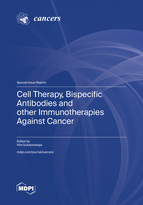Cell Therapy, Bispecific Antibodies and other Immunotherapies Against Cancer
A special issue of Cancers (ISSN 2072-6694). This special issue belongs to the section "Cancer Immunology and Immunotherapy".
Deadline for manuscript submissions: closed (15 June 2023) | Viewed by 38963
Special Issue Editor
2. Department of Medicine, University of Oklahoma, Oklahoma, OK 73126, USA
Interests: immunotherapy; CAR-T cells; tumor microenvironment; checkpoint protein; hypoxia; tumor survival signaling
Special Issues, Collections and Topics in MDPI journals
Special Issue Information
Dear colleagues,
Recently cell therapy became one of the important therapies against different hematological and solid tumors. Cell therapies such as CAR (chimeric antigen receptor)-T, CAR gamma delta T cells, CAR-NK (natural killer) cells and CAR-MA (CAR-macrophages) demonstrated positive results in clinic. These therapies can be autologous or allogeneic using genetically engineered effector cells. The cell therapies can be combined with checkpoint inhibitors against solid tumors to additionally increase their efficacy.
Another very promising therapy against cancer is a therapy with bispecific antibodies engaging T cells or other types of effector cells against cancer. BITEs targeting CD19 antigen are used in clinic against hematological cancers and different designs of bispecific antibodies focused on other targets are used for different types of cancer. Combination of cell therapy with bispecific antibodies and checkpoint inhibitors can be effective way to target tumor and the tumor microenvironment.
Different checkpoint inhibitor antibodies targeting PD-1/PD-L1, LAG3, TIM-3, TIGIT and other pathways recently showed very promising results in clinic.
All these approaches with intracellular signaling, genomics studies, preclinical and clinical results can be used for this issue.
Dr. Vita Golubovskaya
Guest Editor
Manuscript Submission Information
Manuscripts should be submitted online at www.mdpi.com by registering and logging in to this website. Once you are registered, click here to go to the submission form. Manuscripts can be submitted until the deadline. All submissions that pass pre-check are peer-reviewed. Accepted papers will be published continuously in the journal (as soon as accepted) and will be listed together on the special issue website. Research articles, review articles as well as short communications are invited. For planned papers, a title and short abstract (about 100 words) can be sent to the Editorial Office for announcement on this website.
Submitted manuscripts should not have been published previously, nor be under consideration for publication elsewhere (except conference proceedings papers). All manuscripts are thoroughly refereed through a single-blind peer-review process. A guide for authors and other relevant information for submission of manuscripts is available on the Instructions for Authors page. Cancers is an international peer-reviewed open access semimonthly journal published by MDPI.
Please visit the Instructions for Authors page before submitting a manuscript. The Article Processing Charge (APC) for publication in this open access journal is 2900 CHF (Swiss Francs). Submitted papers should be well formatted and use good English. Authors may use MDPI's English editing service prior to publication or during author revisions.
Keywords
- cell therapy
- CAR (chimeric antigen receptor)-T
- bispecific antibodies engaging T cells
- PD-1/PD-L1
- LAG3
- TIM-3
- TIGIT







